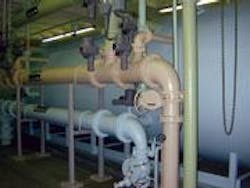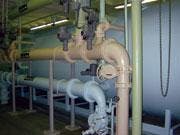Water Agency Reduces Two Contaminants with One Process
By Thomas Dumbaugh
In the early 1990s, Knoxville Water Works of Knoxville, IA, learned that radium levels in its public drinking water supply exceeded those deemed as safe in the Safe Drinking Water Act. Upgrading its then-current water treatment plant, built in the 1960s, would have been costly.
So in the fall of 1994, the city of Knoxville built a new water treatment plant that included two horizontal pressure filters with pre-formed hydrous manganese oxide (HMO) chemical treatment. The 2.4-mgd process removes radium and iron from the city's groundwater supply.
"At the old plant, our radium levels ranged from 7 to 7.5 pCi/l," said Steve Inskeep, general manager of Knoxville Water Works. "We needed to comply with a maximum contaminant level (MCL) of 5 pCi/l for radium, but the old system just couldn't get us there."
Consulting engineering firm Veenstra and Kimm Inc. of West Des Moines suggested contacting USFilter General Filter Products. After assessing the city's needs, the manufacturer installed two horizontal pressure filters with pre-formed HMO chemical treatment.
Three wells provide raw water drawn from the Jordan aquifer to the plant. As water enters the plant, potassium permanganate, manganous sulfate, sodium hypochlorite and sodium hydroxide are blended in a static mixer. The chemicals react in the pipe that connect the mixer to the filters. Sodium hydroxide controls corrosion within the distribution system, and sodium hypochlorite oxidizes the iron and disinfects. Adding manganous sulfate to potassium permanganate oxidizes the manganous ions, forming HMO. Chlorine is added to oxidize excess manganous ions.
Radium is reduced by sorption to the produced manganese oxides. The HMO solution is then captured in the granular media of the pressure filter. The solids build up in the pressure filter until a differential pressure of 3.5 psi is reached. The solids and HMOs containing radium are then backwashed out of the filter, and the waste is sent to the sanitary sewer.
The Knoxville plant uses a backwash waste-holding tank to equalize flow and discharge at a minimum rate to the sanitary sewer. Knoxville's wastewater treatment plant treats the filter backwash waste. WW
About the Author: Thomas (Tom) Dumbaugh, P.E., is a product specialist at USFilter General Filter Products, located in Ames, IA.

